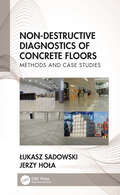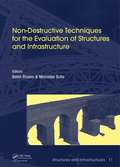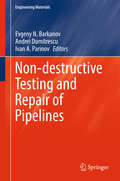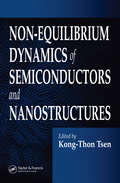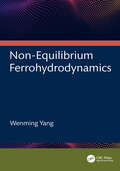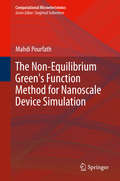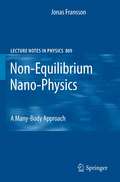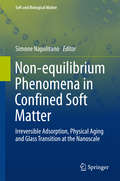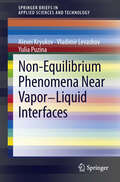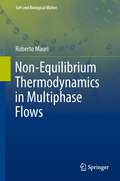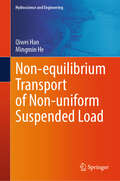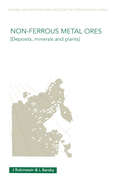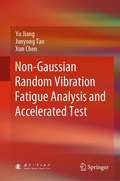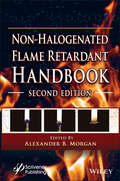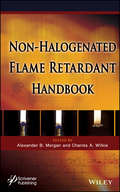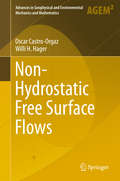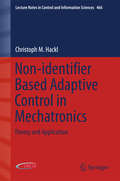- Table View
- List View
Non-Destructive Diagnostics of Concrete Floors: Methods and Case Studies
by Łukasz Sadowski Jerzy HołaConcrete floors should be diagnosed in order to obtain the proper durability. Non-destructive testing (NDT) methods, which have numerous advantages and are very effective for in situ testing, are recommended for this purpose. Non-Destructive Diagnostics of Concrete Floors: Methods and Case Studies offers useful NDT methods, test methodologies, and case studies. This book contains classifications of NDT methods, examines their areas of usefulness in floor diagnostics, and explains the complementarity and reliability of NDT methods as well as the need to calibrate research equipment. It presents interesting case studies of concrete floors, such as dowelled floors, floors with a top layer made of stone slabs, industrial floors, industrial floors with a top layer of polyurethane-cement, layered floors, post-tensioned floors, and cement screeds. The authors have drawn on many years of experience in both academia and the practical diagnosis of concrete floors using NDT methods.
Non-Destructive Evaluation of Corrosion and Corrosion-assisted Cracking
by Raman Singh Baldev Raj U. Kamachi Mudali Prabhakar SinghA comprehensive text to the non-destructive evaluation of degradation of materials due to environment that takes an interdisciplinary approach Non-Destructive Evaluation of Corrosion and Corrosion-assisted Cracking is an important resource that covers the critical interdisciplinary topic of non-destructive evaluation of degradation of materials due to environment. The authors—noted experts in the field—offer an overview of the wide-variety of approaches to non-destructive evaluation and various types of corrosion. The text is filled with instructive case studies from a range of industries including aerospace, energy, defense, and processing. The authors review the most common non-destructive evaluation techniques that are applied in both research and industry in order to evaluate the properties and more importantly degradation of materials components or systems without causing damage. Ultrasonic, radiographic, thermographic, electromagnetic, and optical are some of the methods explored in the book. This important text: Offers a groundbreaking interdisciplinary approach to of non-destructive evaluation of corrosion and corrosion-assisted cracking Discusses techniques for non-destructive evaluation and various types of corrosion Includes information on the application of a variety of techniques as well as specific case studies Contains information targeting industries such as aerospace, energy, processing Presents information from leading researchers and technologists in both non-destructive evaluation and corrosion Written for life assessment and maintenance personnel involved in quality control, failure analysis, and R&D, Non-Destructive Evaluation of Corrosion and Corrosion-assisted Cracking is an essential interdisciplinary guide to the topic.
Non-Destructive In Situ Strength Assessment of Concrete: Practical Application of the RILEM TC 249-ISC Recommendations (RILEM State-of-the-Art Reports #32)
by Denys Breysse Jean-Paul BalayssacThe book presents the work of the RILEM Technical Committee 249-ISC. Addressing the effective application of new recommendations for non-destructive in situ strength assessment of concrete, it provides information about the different steps of the investigation and processing of test results, until the delivery of strength estimates, and includes tables giving the minimum required number of cores in a variety of situations as well as several examples of how the recommendations can be used in practice. The book explores a topic which is of major importance, i.e. the assessment of concrete compressive strength in existing structures. This property (both mean and standard deviation) is a key input in many cases, such as the reinforcement of structures, the safety checking, the extension of service life. As the new RILEM recommendations imply a deep revision (and improvement) of field practice, the book is intended for managers of structures, structural engineers and specialists of NDT that have to answer these issues. More widely, it will benefit engineers and students who are interested in NDT and in the safety analysis of structures.
Non-destructive Materials Characterization and Evaluation (Springer Series in Materials Science #329)
by Walter Arnold Klaus Goebbels Anish KumarThis book is devoted to non-destructive materials characterization (NDMC) using different non-destructive evaluation techniques. It presents theoretical basis, physical understanding, and technological developments in the field of NDMC with suitable examples for engineering and materials science applications. It is written for engineers and researchers in R&D, design, production, quality assurance, and non-destructive testing and evaluation. The relevance of NDMC is to achieve higher reliability, safety, and productivity for monitoring production processes and also for in-service inspections for detection of degradations, which are often precursors of macro-defects and failure of components. Ultrasonic, magnetic, electromagnetic and X-rays based NDMC techniques are discussed in detail with brief discussions on electron and positron based techniques.
Non-Destructive Techniques for the Evaluation of Structures and Infrastructure (Structures and Infrastructures)
by Belén Riveiro Mercedes SollaThis book provides an overview and up-to-date synthesis of the most commonly used non-destructive technologies for the reverse engineering of built infrastructure facilities. These technologies tackle both the geometric and radiometric characterization of built structures, and thus, validated technologies such as laser scanning, photogrammetry, and
Non-destructive Testing and Repair of Pipelines
by Ivan A. Parinov Andrei Dumitrescu Evgeny N. BarkanovThis book describes efficient and safe repair operations for pipelines, and develops new methods for the detection and repair of volumetric surface defects in transmission pipelines. It also addresses the physics, mechanics, and applications of advanced materials used for composite repair of corroded pipelines. Presenting results obtained in the European Commission's INNOPIPES FRAMEWORK 7 programme, it develops long-range ultrasonic and phased array technologies for pipeline diagnostics, and explores their interactions with discontinuities and directional properties of ultrasonic antenna array. The book subsequently shares the results of non-destructive testing for different types of materials applications and advanced composite repair systems, and characterizes the mechanical properties by means of fracture methods and non-destructive techniques. In turn, the book assesses the currently available technologies for reinforcement of pipelines, drawing on the experience gained by project partners, and evaluates the recovery of the carrying capacity of pipeline sections with local corrosion damage by means of analytical and numerical procedures. It develops an optimization method based on the planning of experiments and surface techniques for advanced composite repair systems, before validating the numerical models developed and experimentally gauging the effectiveness of composite repair with the help of full-scale hydraulic tests.
Non-Equilibrium Dynamics of Semiconductors and Nanostructures
by Kong-Thon TsenThe advent of the femto-second laser has enabled us to observe phenomena at the atomic timescale. One area to reap enormous benefits from this ability is ultrafast dynamics. Collecting the works of leading experts from around the globe, Non-Equilibrium Dynamics of Semiconductors and Nanostructures surveys recent developments in a variety of areas in ultrafast dynamics.In eight authoritative chapters illustrated by more than 150 figures, this book spans a broad range of new techniques and advances. It begins with a review of spin dynamics in a high-mobility two-dimensional electron gas, followed by the generation, propagation, and nonlinear properties of high-amplitude, ultrashort strain solitons in solids. The discussion then turns to nonlinear optical properties of nanoscale artificial dielectrics, optical properties of GaN self-assembled quantum dots, and optical studies of carrier dynamics and non-equilibrium optical phonons in nitride-based semiconductors. Rounding out the presentation, the book examines ultrafast non-equilibrium electron dynamics in metal nanoparticles, monochromatic acoustic phonons in GaAs, and electromagnetically induced transparency in semiconductor quantum wells.With its pedagogical approach and practical, up-to-date coverage, Non-Equilibrium Dynamics of Semiconductors and Nanostructures allows you to easily put the material into practice, whether you are a seasoned researcher or new to the field.
Non-equilibrium Evaporation and Condensation Processes: Analytical Solutions (Mathematical Engineering)
by Yuri B. ZudinThis present book is concerned with analytical approaches to statement and solution of problems of non-equilibrium evaporation and condensation. From analytical solutions, one is capable to understand and represent in a transparent form the principal laws, especially in the study of a new phenomenon or a process. This is why analytical methods are always employed on the first stage of mathematical modeling. Analytical solutions are also used as test models for validation of results numerical solutions. Non-equilibrium evaporation and condensation processes play an important role in a number of fundamental and applied problems: laser methods for processing of materials, depressurization of the protection cover of nuclear propulsion units, solar radiation on a comet surface, explosive boiling of superheated liquid, thermodynamic principles of superfluid helium. Analytical relations provide an adequate description of the essence of a physical phenomenon.
Non-Equilibrium Ferrohydrodynamics
by Wenming YangFerrofluids, a synthetic intelligent liquid material, exhibit fascinating flow phenomena when subjected to magnetic fields. This book systematically examines the fundamentals, applications, mathematical derivations, and properties of non-equilibrium ferrohydrodynamics and explores the magnetization and viscosity properties of ferrofluids.The book begins with an introduction to the basic concepts and applications of non-equilibrium ferrohydrodynamics and transport theory. It then goes on to discuss the equations of non-equilibrium and quasi-equilibrium ferrohydrodynamics and the magnetic levitation force in ferrofluids. The author discusses two crucial properties of ferrofluids: magnetization properties and viscosity properties, presenting the ferrofluid magnetization equations and the magnetoviscous effect, an important physical manifestation of non-equilibrium theory. Different types of flows of ferrofluids under the application of different magnetic field configurations are also elucidated, illustrating specific manifestations of non-equilibrium ferrohydrodynamics in different flow patterns.This book will be a valuable reference for researchers and students of mechanical engineering with an interest in fluid dynamics, computational mechanics, and electromagnetism. Professionals working in areas of ferrofluid applications such as mechanics, petrochemical engineering, environmental sciences, and biomedicine will also benefit.
The Non-Equilibrium Green's Function Method for Nanoscale Device Simulation
by Mahdi PourfathFor modeling the transport of carriers in nanoscale devices, a Green-function formalism is the most accurate approach. Due to the complexity of the formalism, one should have a deep understanding of the underlying principles and use smart approximations and numerical methods for solving the kinetic equations at a reasonable computational time. In this book the required concepts from quantum and statistical mechanics and numerical methods for calculating Green functions are presented. The Green function is studied in detail for systems both under equilibrium and under nonequilibrium conditions. Because the formalism enables rigorous modeling of different scattering mechanisms in terms of self-energies, but an exact evaluation of self-energies for realistic systems is not possible, their approximation and inclusion in the quantum kinetic equations of the Green functions are elaborated. All the elements of the kinetic equations, which are the device Hamiltonian, contact self-energies and scattering self-energies, are examined and efficient methods for their evaluation are explained. Finally, the application of these methods to study novel electronic devices such as nanotubes, graphene, Si-nanowires and low-dimensional thermoelectric devices and photodetectors are discussed.
Non-equilibrium Many-body States in Carbon Nanotube Quantum Dots (Springer Theses)
by Tokuro HataThis book presents the first experiment revealing several unexplored non-equilibrium properties of quantum many-body states, and addresses the interplay between the Kondo effect and superconductivity by probing shot noise. In addition, it describes in detail nano-fabrication techniques for carbon nanotube quantum dots, and a measurement protocol and principle that probes both equilibrium and non-equilibrium quantum states of electrons. The book offers various reviews of topics in mesoscopic systems: shot noise measurement, carbon nanotube quantum dots, the Kondo effect in quantum dots, and quantum dots with superconducting leads, which are relevant to probing non-equilibrium physics. These reviews offer particularly valuable resources for readers interested in non-equilibrium physics in mesoscopic systems. Further, the cutting-edge experimental results presented will allow reader to catch up on a vital new trend in the field.
Non-Equilibrium Nano-Physics: A Many-Body Approach
by Jonas FranssonThe aim of this book is to present a formulation of the non-equilibrium physics in nanoscale systems in terms of many-body states and operators and, in addition, discuss a diagrammatic approach to Green functions expressed by many-body states. The intention is not to give an account of strongly correlated systems as such. Thus, the focus of this book ensues from the typical questions that arise when addressing nanoscale systems from a practical point of view, e.g. current-voltage asymmetries, negative differential conductance, spin-dependent tunneling. The focus is on nanoscale systems constituted of complexes of subsystems interacting with one another, under non-equilibrium conditions, in which the local properties of the subsystems are preferably being described in terms of its (many-body) eigenstates.
Non-equilibrium Phenomena in Confined Soft Matter
by Simone NapolitanoThis book deals with those properties of non-equilibrium soft matter that deviate greatly from the bulk properties as a result of nanoscale confinement. The ultimate physical origin of these confinement effects is not yet fully understood. At the state of the art, the discussion on confinement effects focuses on equilibrium properties, finite size effects and interfacial interactions. However this is a limited vision which does not fully capture the peculiar behaviour of soft matter under confinement and some exotic phenomena that are displayed. This volume will be organized in the following three main themes. Equilibration and physical aging: treating non-equilibrium via the formal methodology of statistical physics in bulk, we analyse physical origin of the non-equilibrium character of thin polymer. We then focus on the impact of nanoconfinement on the equilibration of glasses of soft matter (a process of tremendous technological interest, commonly known as physical aging), comparing the latest trends of polymers in experiments, simulations with those of low-molecular weight glass formers. Irreversible adsorption: the formation of stable adsorbed layers occurs at timescales much larger than the time necessary to equilibrate soft matter in bulk. Recent experimental evidence show a strong correlation between the behaviour of polymers under confinement and the presence of a layer irreversibly adsorbed onto the substrate. This correlation hints at the possibility to tailor the properties of ultrathin films by controlling the adsorption kinetics. The book reports physical aspects of irreversible chain adsorption, such as the dynamics, structure, morphology, and crystallization of adsorbed layers. Glass transition and material properties: this section of the book focuses on the spread of absolute values in materials properties of confined systems, when measured by different experimental and computation techniques and a new method to quantify the effects of confinement in thin films and nanocomposites independently on the investigation procedure will be presented.
Non-Equilibrium Phenomena near Vapor-Liquid Interfaces
by Yulia Puzina Alexei Kryukov Vladimir LevashovThis book presents information on the development of a non-equilibrium approach to the study of heat and mass transfer problems using vapor-liquid interfaces, and demonstrates its application to a broad range of problems. In the process, the following peculiarities become apparent: 1. At vapor condensation on the interface from gas-vapor mixture, non-condensable components can lock up the interface surface and condensation stops completely. 2. At the evolution of vapor film on the heater in superfluid helium (He-II), the boiling mass flux density from the vapor-liquid interface is effectively zero at the macroscopic scale. 3. In problems concerning the motion of He-II bridges inside capillaries filled by vapor, in the presence of axial heat flux the He-II bridge cannot move from the heater as would a traditional liquid, but in the opposite direction instead. Thus the heater attracts the superfluid helium bridge. 4. The shape of liquid-vapor interface at film boiling on the axis-symmetric heaters immersed in liquid greatly depends on heat flux in the interface. Thus a new type of hydrostatic problems appears when in contrast to traditional statements the shape of the liquid-vapor interface has a complex profile with a point of inflection and a smooth exit on a free liquid surface.
Non-Equilibrium Thermodynamics in Multiphase Flows
by Roberto MauriNon-equilibrium thermodynamics is a general framework that allows the macroscopic description of irreversible processes. This book introduces non-equilibrium thermodynamics and its applications to the rheology of multiphase flows. The subject is relevant to graduate students in chemical and mechanical engineering, physics and material science. This book is divided into two parts. The first part presents the theory of non-equilibrium thermodynamics, reviewing its essential features and showing, when possible, some applications. The second part of this book deals with how the general theory can be applied to model multiphase flows and, in particular, how to determine their constitutive relations. Each chapter contains problems at the end, the solutions of which are given at the end of the book. No prior knowledge of statistical mechanics is required; the necessary prerequisites are elements of transport phenomena and on thermodynamics. "The style of the book is mathematical, but nonetheless it remains very readable and anchored in the physical world rather than becoming too abstract. Though it is up-to-date and includes recent important developments, there is a lot of classical material in the book, albeit presented with unprecedented clarity and coherence. The first six chapters are actually a very good introduction to the theory underlying many phenomena in soft matter physics, beyond the focus on flow and transport of the later chapters of the book." Prof Richard A.L. Jones FRS, Pro-Vice-Chancellor for Research and Innovation, University of Sheffield
Non-equilibrium Transport of Non-uniform Suspended Load (Hydroscience and Engineering)
by Qiwei Han Mingmin HeThe book is based on stochastic theory of sediment motion, particularly the theory of transition intensities. It provides a complete theory and equation system of non-equilibrium transport of non-uniform suspended load. The content proposed theory reports, for the first time in literature, the general boundary condition of diffusion equations of non-equilibrium transport with transition intensities. The book also introduces the theoretical expressions of size distribution of the carrying sediment capacity, efficient bed material grade, and saturation recovery coefficient This book describes the application of non-equilibrium transport theory and provides solutions to some long-standing unsolved controversial problems related to sediment transport. It establishes a generic mathematic model of reservoir sedimentation and river channel evolution; illustrates the same transport regulars of wash load and bed material load; demonstrates the multi-valued nature of carrying-sediment capacity and its single-valued consideration; and describes the mechanism of bed material coarsening. This book is of interest to a wide audience including students, technicians, and academics, primarily working in the field of river hydra-dynamics. In addition, this book receives attention from the research community working in fields, such as hydrogeology, hydraulic engineering, river navigation, wastewater treatment, and environmental protection
Non-Ferrous Metal Ores: Deposits, Minerals and Plants
by Julius RubinsteinThis volume presents information on mineral resources of non-ferrous metals, with a particular emphasis on practices in the former USSR. The author reviews the geographical distribution, geology, mining and ore processing plants of the former Soviet Union. Non-ferrous metal ores are classified in the text, and mineral processing technologies are de
Non-Formal and Informal Science Learning in the ICT Era (Lecture Notes in Educational Technology)
by Michail GiannakosThis book introduces the reader to evidence-based non-formal and informal science learning considerations (including technological and pedagogical innovations) that have emerged in and empowered the information and communications technology (ICT) era. The contributions come from diverse countries and contexts (such as hackerspaces, museums, makerspaces, after-school activities) to support a wide range of educators, practitioners, and researchers (such as K-12 teachers, learning scientists, museum curators, librarians, parents, hobbyists). The documented considerations, lessons learned, and concepts have been extracted using diverse methods, ranging from experience reports and conceptual methods to quantitative studies and field observation using qualitative methods. This volume attempts to support the preparation, set-up, implementation, but also evaluation of informal learning activities to enhance science education.
Non-Gaussian Random Vibration Fatigue Analysis and Accelerated Test
by Yu Jiang Junyong Tao Xun ChenThis book discusses the theory, method and application of non-Gaussian random vibration fatigue analysis and test. The main contents include statistical analysis method of non-Gaussian random vibration, modeling and simulation of non-Gaussian/non-stationary random vibration, response analysis under non-Gaussian base excitation, non-Gaussian random vibration fatigue life analysis, fatigue reliability evaluation of structural components under Gaussian/non-Gaussian random loadings, non-Gaussian random vibration accelerated test method and application cases. From this book, the readers can not only learn how to reproduce the non-Gaussian vibration environment actually experienced by the product, but also know how to evaluate the fatigue life and reliability of the structure under non-Gaussian random excitation.
Non-Gaussian Statistical Communication Theory
by David MiddletonThe book is based on the observation that communication is the central operation of discovery in all the sciences. In its "active mode" we use it to "interrogate" the physical world, sending appropriate "signals" and receiving nature's "reply". In the "passive mode" we receive nature's signals directly. Since we never know a prioriwhat particular return signal will be forthcoming, we must necessarily adopt a probabilistic model of communication. This has developed over the approximately seventy years since it's beginning, into a Statistical Communication Theory (or SCT). Here it is the set or ensemble of possible results which is meaningful. From this ensemble we attempt to construct in the appropriate model format, based on our understanding of the observed physical data and on the associated statistical mechanism, analytically represented by suitable probability measures.Since its inception in the late '30's of the last century, and in particular subsequent to World War II, SCT has grown into a major field of study. As we have noted above, SCT is applicable to all branches of science. The latter itself is inherently and ultimately probabilistic at all levels. Moreover, in the natural world there is always a random background "noise" as well as an inherent a priori uncertainty in the presentation of deterministic observations, i.e. those which are specifically obtained, a posteriori.The purpose of the book is to introduce Non-Gaussian statistical communication theory and demonstrate how the theory improves probabilistic model. The book was originally planed to include 24 chapters as seen in the table of preface. Dr. Middleton completed first 10 chapters prior to his passing in 2008. Bibliography which represents remaining chapters are put together by the author's close colleagues; Drs. Vincent Poor, Leon Cohen and John Anderson.email pressbooks@ieee.org to request Ch.10
Non-halogenated Flame Retardant Handbook
by Alexander B. MorganThis book focuses on non-halogenated flame retardants with an emphasis on practical and applied issues, and builds upon the 1st edition, but is not just a re-do/re-edit of 1st edition content. While non-halogenated flame retardants have not greatly changed since the 1st edition was published in 2014, there have been enough advances and changes to merit a 2nd edition. The book would include chapters on regulation and drivers for non-halogenated flame retardants, specific chapters on each of the major classes of flame retardants, and would include some newer technologies / niche non-halogenated solutions which are either starting to enter the market (coatings / bio-derived flame retardants) or are at least being studied with enough detail to bring to the attention of the reader. As with the 1st edition, the 2nd edition still takes a practical approach to addressing the narrow subject of non-halogenated flame retardancy. This includes more emphasis on flame retardant selection for specific plastics, practical considerations in flame retardant material design, and what the strengths and limits of these various technologies are. Previous flame retardant material science books have covered non-halogenated flame retardants, but they focus more on how they work rather than how to use them. This book focuses more on the practical uses, hence the title of the book “Handbook”, which should make it of good use to industrial chemists and material scientists.
The Non-halogenated Flame Retardant Handbook
by Alexander B. Morgan Charles A. WilkieDue to the emphasis on replacing halogenated flame retardants with alternate technologies, this handbook contains in one place all of the current commercial non-halogenated flame retardant technologies, as well as experimental systems near commercialization. This book focuses on non-halogenated flame retardants in a holistic but practical manner. It starts with an overview of the regulations and customer perceptions driving non-halogenated flame retardant selection over older halogenated technologies. It then moves into separate chapters covering the known major classes of non-halogenated flame retardants. These chapters are written by known experts in those specific chemistries who are also industrial experts in how to apply that technology to polymers for fire safety needs. The handbook concludes with some of the newer technologies in place that are either niche performers or may be commercial in the near future. Future trends in flame retardancy are also discussed.The Non-Halogenated Flame Retardant Handbook book takes a practical approach to addressing the narrow subject of non-halogenated flame retardancy. This includes more emphasis on flame retardant selection for specific plastics, practical considerations in flame retardant material design, and what the strengths and limits of these various technologies are. Previous flame retardant material science books have covered non-halogenated flame retardants, but they focus more on how they work rather than how to use them.
Non-Hydrostatic Free Surface Flows
by Oscar Castro-Orgaz Willi H. HagerThis book provides essential information on the higher mathematical level of approximation over the gradually varied flow theory, also referred to as the Boussinesq-type theory. In this context, it presents higher order flow equations, together with their applications in a broad range of pertinent engineering and environmental problems, including open channel, groundwater, and granular material flows.
Non-Ideal Compressible Fluid Dynamics for Propulsion and Power: Selected Contributions from the 2nd International Seminar on Non-Ideal Compressible Fluid Dynamics for Propulsion & Power, NICFD 2018, October 4-5, 2018, Bochum, Germany (Lecture Notes in Mechanical Engineering)
by Francesca Di Mare Andrea Spinelli Matteo PiniThis book reports on advanced theories and methods aimed at characterizing the dynamics of non-ideal compressible fluids. A special emphasis is given to research fostering the use of non-ideal compressible fluids for propulsion and power engineering. Both numerical and experimental studies, as well as simulations, are described in the book, which is based on selected contributions and keynote lectures presented at the 2nd International Seminar on Non-Ideal Compressible-Fluid Dynamics for Propulsion & Power. Held on October 4-5 in Bochum, Germany, the seminar aimed at fostering collaborations between academics and professionals. The two perspectives have been gathered together in this book, which offers a timely guide to advanced fundamentals, innovative methods and current applications of non-ideal compressible fluids to developing turbomachines, and for propulsion and power generation.
Non-identifier Based Adaptive Control in Mechatronics
by Christoph M. HacklThis book introduces non-identifier-based adaptive control (with and without internal model) and its application to the current, speed and position control of mechatronic systems such as electrical synchronous machines, wind turbine systems, industrial servo systems, and rigid-link, revolute-joint robots. In mechatronics, there is often only rough knowledge of the system. Due to parameter uncertainties, nonlinearities and unknown disturbances, model-based control strategies can reach their performance or stability limits without iterative controller design and performance evaluation, or system identification and parameter estimation. The non-identifier-based adaptive control presented is an alternative that neither identifies the system nor estimates its parameters but ensures stability. The adaptive controllers are easy to implement, compensate for disturbances and are inherently robust to parameter uncertainties and nonlinearities. For controller implementation only structural system knowledge (like relative degree, input-to-state stable zero dynamics and known sign of the high-frequency gain) is required. Moreover, the presented controllers guarantee reference tracking with prescribed asymptotic or transient accuracy, i. e. the tracking error eventually tends to or for all time evolves within an a priori specified region. The book presents the theory, modeling and application in a general but detailed and self-contained manner, making it easy to read and understand, particularly for newcomers to the topics covered
